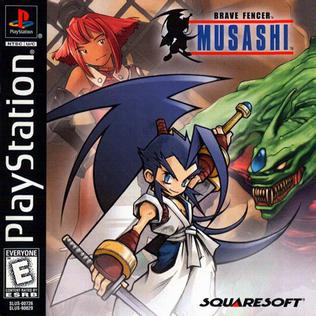
Brave Fencer Musashi is an action role-playing video game developed and published by Square in 1998 for the PlayStation home console. The game involves real-time sword-based combat in a 3D environment; it also features segments of voiced over dialogue and role-playing game elements such as a day-night cycle and resting to restore energy.
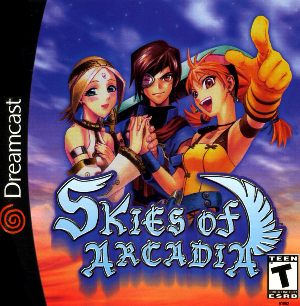
Skies of Arcadia is a 2000 Dreamcast role-playing video game developed by Overworks and published by Sega. Players control Vyse, a young air pirate, and his friends as they attempt to stop the Valuan Empire from reviving ancient weapons with the potential to destroy the world.

Torneko: The Last Hope is a 1999 role-playing video game for the PlayStation. The game was co-developed by Chunsoft and Matrix Software and published by Enix. In Japan, the game was ported to the Game Boy Advance in 2001.
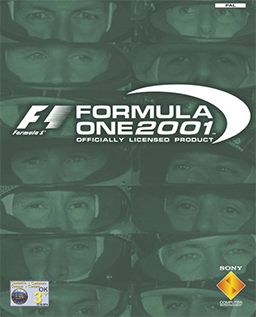
Formula One 2001 is a racing video game developed by Studio 33 for the PlayStation version and Studio Liverpool for the PlayStation 2 version and published by Sony Computer Entertainment Europe in PAL regions for both systems. The PlayStation 2 version was published in North America by Sony Computer Entertainment America under the 989 Sports brand. It is a sequel to the 2000 video game Formula One 2000 and was based on the 2001 Formula One World Championship. This is the last game to be released in North America until Formula One Championship Edition.
Fighter Maker(格闘ツクール, Kakutō Tsukūru) is a series of games for PlayStation consoles and Microsoft Windows. It features a robust character creation system, letting players even create animations. There are two versions of the games, Fighter Maker and 2D Fighter Maker.

Fantavision, sometimes stylized as FantaVision, is a puzzle video game developed by Japan Studio and published by Sony Computer Entertainment for the PlayStation 2 (PS2). The game's objective is to use a cursor to select three or more launched fireworks of the same color in a row and then to detonate them to increase the player's score. Used in conjunction with various power-ups, the resulting explosions can ignite and chain together even more flares for additional points.

Armored Core 2 is a 2000 third-person shooter mecha video game developed by FromSoftware for the PlayStation 2. It is the fourth entry in the Armored Core series and an indirect sequel to Armored Core: Master of Arena. In North America, Armored Core 2 was a launch title for the PlayStation 2. A direct sequel, Armored Core 2: Another Age, was released in 2001 for the PlayStation 2.

Armored Core 3 is a 2002 third-person shooter mecha video game developed by FromSoftware for the PlayStation 2. It is the sixth entry in the Armored Core series. Armored Core 3 acts as a reboot for the franchise and begins a storyline that would continue through Armored Core: Last Raven. In 2009, Armored Core 3 was ported to the PlayStation Portable.

Silent Line: Armored Core, known in Japan as Armored Core 3: Silent Line, is a 2003 third-person shooter mecha video game developed by FromSoftware for the PlayStation 2. It is the seventh entry in the Armored Core series and a direct sequel to 2002's Armored Core 3. In 2009, Silent Line: Armored Core was ported to the PlayStation Portable.

Armored Core: Nexus is a 2004 third-person shooter mecha video game developed by FromSoftware for the PlayStation 2. It is the eighth entry in the Armored Core series and a sequel to 2003's Silent Line: Armored Core. Unlike Silent Line, Nexus is not an expansion but rather a full-fledged sequel.

Armored Core: Nine Breaker is a 2004 third-person shooter mecha video game developed by FromSoftware for the PlayStation 2. It is the ninth entry in the Armored Core series and a spin-off to Armored Core: Nexus.
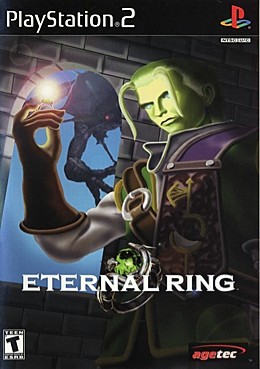
Eternal Ring is a first-person action role-playing game developed by FromSoftware and published in North America by Agetec. Released in 2000, it was a launch title for the PlayStation 2 both in Japan and North America. The game was made available via emulation for the PlayStation 4 in North America on May 23, 2017.

Ephemeral Fantasia, known in Japan as Reiselied: Ephemeral Fantasia, is a 2000 role-playing video game developed by Konami Computer Entertainment Japan and published by Konami for the PlayStation 2. The game was released in Japan on August 10, 2000, in North America on July 9, 2001 and in Europe on September 7, 2001.
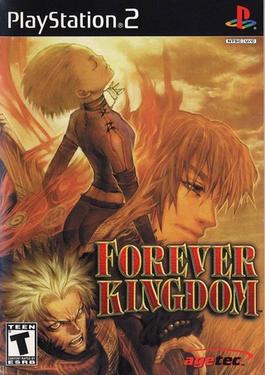
Forever Kingdom, known in Japan as Evergrace II, is an action role-playing game released for the PlayStation 2 by FromSoftware. It is the prequel to Evergrace.
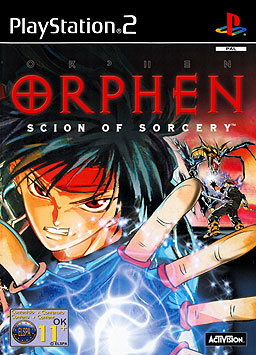
Orphen: Scion of Sorcery, known in Japan as Sorcerous Stabber Orphen, is an action role-playing video game for the PlayStation 2. The game was developed by SHADE Inc. co-published by Kadokawa Shoten and ESP in Japan, and released abroad by Activision. Its lore is based on the light novel series Sorcerous Stabber Orphen by Yoshinobu Akita. The name 'Orphen' is officially derived from the word 'orphan', but also has a resemblance to Ancient Greek Orpheus, who has surprising connections to ancient Japan and ancient India. The game was a launch title for the PlayStation 2 in North America and Europe.

Innocent Life: A Futuristic Harvest Moon, also known as Harvest Moon: Innocent Life, is a 2006 farming simulation video game for the PlayStation Portable (PSP). It is a spin-off of the Story of Seasons series of games, and was released on April 27, 2006, in Japan and in 2007 for the rest of the world.
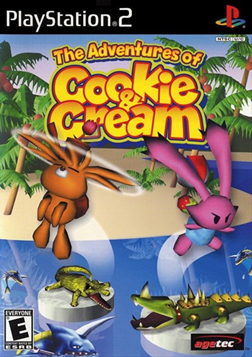
The Adventures of Cookie & Cream, known as Kuri Kuri Mix in Japan and Europe, is an action-adventure video game developed by FromSoftware for the PlayStation 2 released in 2000. In 2007, it was ported to the Nintendo DS as Cookie & Cream.
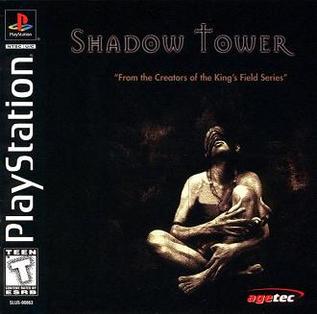
Shadow Tower is a 1998 action role-playing video game developed by FromSoftware for the PlayStation. The game was originally released in Japan by FromSoftware on June 25, 1998 and in North America by Agetec on November 23, 1999. Shadow Tower shares many similarities with the King's Field series of video games. A sequel, Shadow Tower Abyss, was released for the PlayStation 2 exclusively in Japan.

King's Field IV, released in North America as King's Field: The Ancient City is a 2001 action role-playing game developed by FromSoftware for the PlayStation 2. It is the fourth entry in the King's Field series. It was released in North America by Agetec in 2002 and in Europe by Metro3D in 2003.

FIFA 2001 is a football simulation video game and the sequel to FIFA 2000. It was succeeded by FIFA Football 2002. It features Paul Scholes on the UK cover and Ben Olsen on the North American cover. The game's Spanish cover features Gaizka Mendieta on it. It was released on 31 October 2000 for Microsoft Windows and PlayStation, and on 24 November 2000 for PlayStation 2 as a launch title in Europe. The PlayStation 2 version was originally slated for release in the U.S. on 7 November, before it was delayed to 28 November. A Game Boy Color version was planned but cancelled.


















